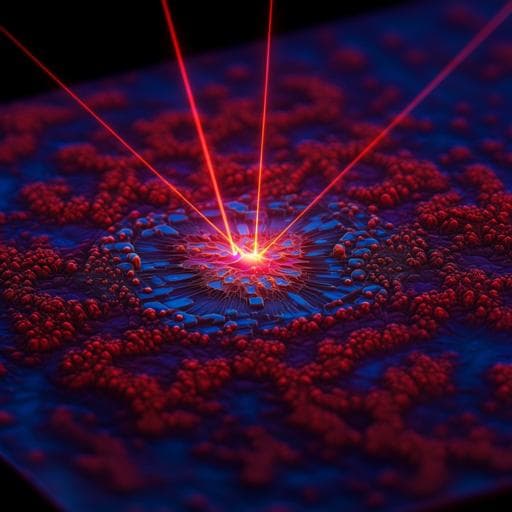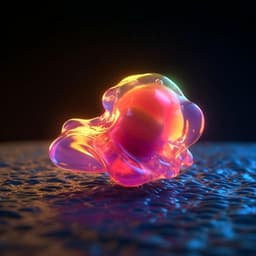
Engineering and Technology
Nanoscale reshaping of resonant dielectric microstructures by light-driven explosions
M. R. Shcherbakov, G. Sartorello, et al.
Discover groundbreaking advancements in nanofabrication as researchers, including Maxim R. Shcherbakov and Giovanni Sartorello, unveil techniques for creating deeply subwavelength silicon features using localized laser-induced phase explosions. This innovative approach achieves high aspect ratio nanotrenches, pushing the boundaries of precision in engineering microstructures.
~3 min • Beginner • English
Introduction
The study addresses the challenge of surpassing the diffraction limit in laser-based material processing, which constrains minimum feature sizes to ~λ/2n. Traditional approaches using multiphoton absorption or ultrafast ablation of planar surfaces are limited in pattern diversity and resolution. Plasmonic structures can concentrate fields below the diffraction limit but typically localize features to ~λ/10 and rely on metallic hot spots. The authors propose a resonant all-dielectric strategy—using engineered silicon microresonators excited by mid-infrared femtosecond pulses—to localize energy volumetrically and drive nanoscale explosions that form deep-subwavelength trenches. They hypothesize that resonant field enhancement, highly nonlinear carrier generation, and volumetric coupling in high-Q dielectric microstructures enable controllable sub-λ/50 material removal with lower incident fluence than flat-surface ablation, offering a scalable route to nanoscale fabrication.
Literature Review
Prior work established ultrafast laser ablation and nanomorphing in dielectrics and semiconductors, leveraging non-thermal mechanisms and multiphoton processes but largely confined to planar surfaces and limited pattern types (craters, particle formation). Near-field plasmonic enhancement has enabled sub-diffraction localization and nanoparticle reshaping, yet feature sizes typically remain ~λ/10 and depend on linear hot-spot formation in metals. All-dielectric resonators have emerged as a platform for strong local field enhancements and nonlinear interactions, and analogous Mie-resonant phenomena have been observed macroscopically (e.g., microwave grape effects). The literature also discusses limits from plasma density on coupling in bulk materials, ablation thresholds, and mechanisms such as Brunel and resonant absorption, Coulomb and phase explosions. This work extends these paradigms by using resonant dielectric microstructures to achieve deeper subwavelength ablation with lower fluence and richer control modalities (polarization, shot count) than prior surface or plasmonic approaches.
Methodology
- Sample fabrication: Arrays of M-shaped silicon microresonators were patterned on silicon-on-sapphire wafers with a 600 nm silicon layer. Electron-beam lithography in PMMA resist (baked 12 min at 90 °C, 1000 µC cm⁻² dose with PEC) defined patterns. A 30 nm Cr hard mask was thermally evaporated, lift-off performed in acetone with sonication, followed by HBr reactive ion etching to transfer the pattern and wet Cr etch to remove the mask. Arrays spanned 600×300 µm² to 690×345 µm² to ensure fresh irradiation spots.
- Optical characterization: FTIR spectroscopy measured resonances near λ_res ≈ 4 µm for polarization along the base of the M-shaped resonators, showing a transmission dip. Local-field distributions were modeled with COMSOL to identify a magnetic-dipole mode and hot spots.
- Laser irradiation (λ₁ = 3.9 µm): Trains of 200 fs, linearly polarized MIR pulses from an OPA (per-pulse energy up to 6 µJ) were focused to a 36 µm FWHM spot. Peak fluence up to ~0.28 J cm⁻² and average intensity up to ~1.4 TW cm⁻² were used, intentionally below the pristine bulk Si damage threshold (~0.5 J cm⁻²). Pulse counts N were varied from 1 to 100 via a synchronized mechanical shutter; polarization angle θ was controlled with a half-waveplate; power with wire-grid polarizers. The beam was profiled with a MIR profiler; fresh sample spots were used with ≥50 µm step size.
- Laser irradiation (λ₁ ≈ 6.9–7 µm): Similar experiments were conducted at ALLS using a Ti:Sapphire-pumped OPA with DFG to 7 µm (50 Hz, up to 50 µJ per pulse), focused with a 50 mm focal length ZnSe lens to ~40 µm waist. Pulse counts controlled via shutters; polarization and power via wire-grid polarizer and half-waveplate.
- Imaging: Post-irradiation SEM (Zeiss Supra, 1 kV, no discharge layer) was used to measure trench morphology and widths; FTIR spectra collected with Bruker Vertex 70 using a ZnSe lens.
- Simulations: 3D particle-in-cell simulations (EPOCH) with custom refractive index and dynamic Keldysh photoionization modules modeled interaction of a 200 fs, 3.9 µm pulse at 0.1 J cm⁻² with the resonator. Simulation domain: 2.13×2.13×3 µm³ with periodic x–z and y–z boundaries; spatial resolution ~21.3 nm (x,y) and 25 nm (z). The silicon resonator (0.6 µm thick, outer sides 1.21 µm, chamfered corners; notch triangular 0.83 µm altitude/base) was placed on a 0.9 µm Al2O3 substrate (ionization suppressed). Initial temperature 300 K; Si optical refractive index 3.43; Al2O3 index 1.68. Each cell had 2048 macroparticles (each representing 275 Si atoms). Direct interband excitation was modeled; collisions, Keldysh ionization, and carrier dynamics included. Total simulated time 440 fs.
- Analytical estimates: Hot-spot field enhancement (~5× E-field; ~25× intensity) and resulting ponderomotive/oscillatory energy, Keldysh parameter (γ_K < 1 in MIR), and post-tunneling displacement near the Si–air interface were estimated to rationalize electron escape and nanoscale ablation.
Key Findings
- Deeply subwavelength trenches were formed in resonant silicon microresonators using MIR femtosecond pulses:
- Minimum trench width as low as ~λ/80 (≈50 nm) with aspect ratio >10:1 (h/w ≈ 12:1 for 600 nm thick resonators) using N = 100 pulses at sub-threshold fluence (~0.09–0.1 J cm⁻²).
- Across the beam profile (λ = 3.9 µm, N = 100, J₁ ≈ 0.19 J cm⁻²), trench widths ranged from ~115 nm to ~280 nm (≈λ/34 to λ/14), largest at beam center.
- Trench formation initiates around N ≈ 10–20 pulses and becomes fully formed by N ≈ 30 pulses (for suitable fluence).
- Lateral propagation rate of the trench front v_ab ≈ 30 nm per pulse; trench spans the full 600 nm thickness (volumetric ablation).
- Control parameters:
- Polarization controls trench orientation; changing θ from 0° to tilted angles (e.g., 45–80°) leads to asymmetric carrier distributions and trench directions perpendicular to the polarization plane.
- Peak fluence controls trench width; at λ ≈ 7 µm, widths varied from ~150 nm at 0.15 J cm⁻² (≈λ/50) to ~550 nm at 1.2 J cm⁻².
- Process scalable with wavelength: at λ₁ ≈ 6.9–7 µm, trench seeded at N ≈ 10, halfway at N ≈ 30, fully trenched by N ≈ 50.
- Reduced threshold vs flat surfaces: Resonant enhancement enables dense e–h plasma (n_p ~10²² cm⁻³) and ablation at incident fluence J_thr ≈ 0.1 J cm⁻²—almost an order of magnitude lower than typical multiphoton patterning of flat Si.
- Mechanism and simulations:
- Three-step model: (I) multiphoton/tunneling plasma generation; (II) field redistribution forming an apex hot spot in the plasma-filled resonator; (III) localized Coulomb/phase explosions eject material.
- PIC simulations show localized |E|² enhancement at apex and sides, near-solid-density plasma formation after t = 0, and rapid ion heating. A rod-shaped molten region (≥1683 K) penetrates the resonator with an inner boiling front (≥2628 K), peak temperatures up to ~10⁴ K, and characteristic diameter ~100 nm, consistent with experiments.
- Analytical estimates yield oscillatory energy U_osc ≈ 18 eV at hot spots and post-tunneling displacement Δ_hs ~16–25 nm, supporting electron escape and observed ablation rate (~30 nm/pulse).
Discussion
Resonant all-dielectric microresonators enable volumetric coupling and field buildup that circumvent limitations in flat-surface ablation, where high carrier densities impede coupling. The high-Q response concentrates energy at engineered hot spots; nonlinear multiphoton/tunneling ionization in MIR produces compact high-density plasmas that reshape mode profiles, further localizing fields at the apex and sidewalls. This cascade of localization—from micron-scale beam to sub-100 nm ablation zone—permits λ/80 features at incident fluences ~0.1 J cm⁻². Simulations corroborate the three-step mechanism and timescales: sub-ps formation of a rod-like molten/boiling region with extreme temperature gradients suggests phase explosion and material ejection before significant thermal diffusion occurs; Coulomb explosion is also plausible given sufficient electron energy for escape and ionization. Polarization dictates carrier injection asymmetry and thus trench direction, providing an additional control knob. MIR excitation is advantageous due to larger resonator dimensions (ease of fabrication), higher ponderomotive energies at given intensities, and favorable Keldysh tunneling conditions (γ_K < 1), enabling efficient, localized carrier generation and electron escape. Overall, these findings validate FLANEM as a controllable, scalable route to deep-subwavelength nanostructuring.
Conclusion
The work demonstrates femtosecond-laser-assisted nanoscale reshaping of silicon microresonators, producing deeply subwavelength nanotrenches (~λ/80, aspect ratio >10:1) that propagate at ~30 nm per pulse, span the full device thickness, and can be controlled via pulse number, fluence, and polarization. The approach operates at lower fluences than flat-surface multiphoton patterning and scales with wavelength. PIC simulations and analytical estimates support a mechanism based on resonantly enhanced field localization, dense carrier generation, and localized phase/Coulomb explosions. Future research should explore dependence on microresonator geometry (minimum features, apex sharpness), electromagnetic mode distributions, material systems to tailor explosion dynamics and scales, and diagnostic studies (e.g., time-of-flight mass spectrometry) to further resolve the dominant ablation mechanism.
Limitations
- The exact origin of polarization-induced asymmetry in trench formation remains under investigation (possible roles of Brunel electron recollision asymmetry and stress-induced crack propagation along crystallographic axes).
- The dominant ablation pathway (phase versus Coulomb explosion) is not conclusively identified; additional diagnostics such as time-of-flight mass spectrometry are needed.
- The method relies on prefabricated resonant microstructures; impacts of resonator geometry, minimum feature sizes, and mode distributions on nanostructuring limits require systematic study.
- Results demonstrated on silicon-on-sapphire; generalization to other materials and substrates will influence dynamics and achievable scales.
Related Publications
Explore these studies to deepen your understanding of the subject.







